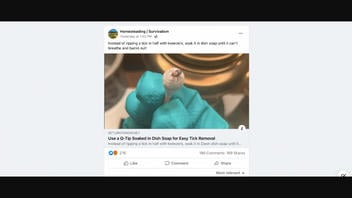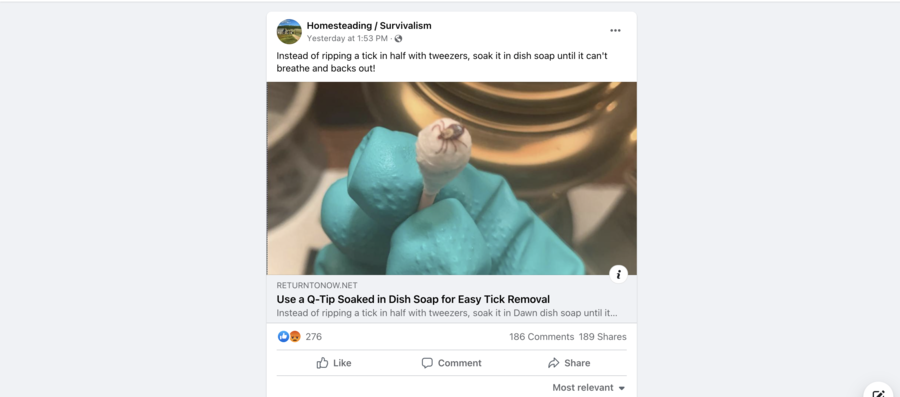
Can a person remove a tick with just dish soap and a cotton swap? No, that's not true: This will not work unless the tick is engorged and already ready to let go, Barry OConnor, an expert in parasites at the University of Michigan, told Lead Stories. OConnor, the Centers for Disease Control and Prevention (CDC) and Johns Hopkins Lyme Disease Research Center all recommend tweezers as the most effective way to remove ticks from skin.
The claim appeared in a Facebook post on May 23, 2022. It opens:
Instead of ripping a tick in half with tweezers, soak it in dish soap until it can't breathe and backs out!
This is what the post looked like on Facebook at the time of writing:
The link in the post reroutes the user to returntonow.net, which claims that a nurse posted on Facebook about a tick removal trick. "Instead of trying to pull them off with your fingers, tweezers, or those fancy gizmos you can buy for tick removal, simply take a q-tip and dip it in liquid soap like Dawn dish soap, and start making small circles around the tick. The soap fills the tick's lungs and they can't breathe, so they let go of the skin and come right off!"
The CDC recommends using fine-tipped tweezers. While grasping the tick as close to the skin's surface as possible, pull up in an even motion. After removing the tick, clean the bite area and your hands with soap and water. The full how-to guide and instructions of how to dispose of the tick can be found here.
John Hopkins Lyme Disease Research Center recommends similar tactics when faced with a tick bite.
OConnor, an expert in parasitology and a professor emeritus at the University of Michigan, emailed us on May 25, 2022. He said the dish soap method "will not generally work unless the tick is fully engorged and ready to detach already." Many ticks secrete a substance around their mouth-parts called "cement" when they attach to a host. Once that "cement" hardens, nothing will make the tick detach until it has finished feeding. After feeding, an enzyme is released from the tick that dissolves the "cement."
OConnor said the only effective way to remove a tick is to use fingernails, tweezers or a specific device that can get as close to the skin as possible. "The goal is to remove the tick with its mouthparts intact, otherwise they may be left in the skin and lead to irritation or infection," he said.

















